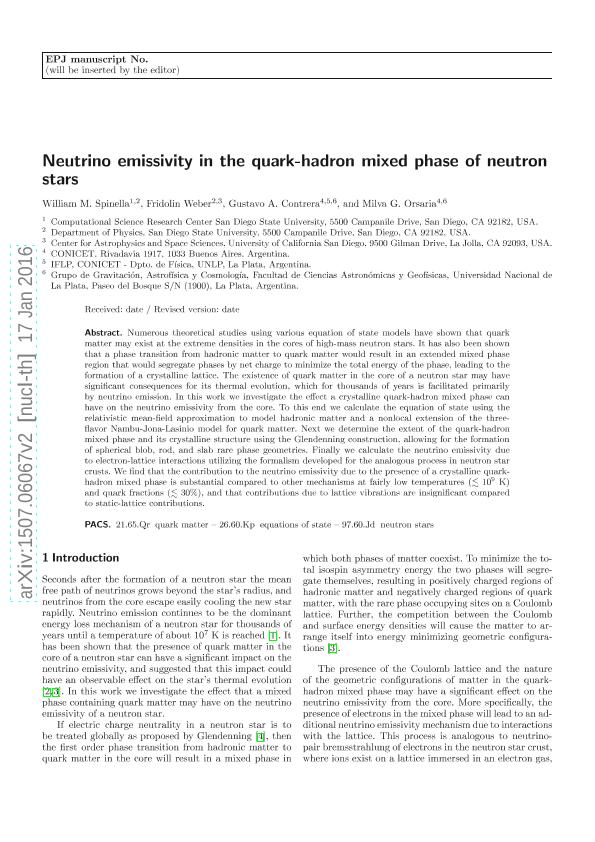Mostrar el registro sencillo del ítem
dc.contributor.author
Spinella, William M.
dc.contributor.author
Weber, Fridolin

dc.contributor.author
Contrera, Gustavo Aníbal Gabriel

dc.contributor.author
Orsaria, Milva Gabriela

dc.date.available
2018-08-06T23:25:09Z
dc.date.issued
2016-03
dc.identifier.citation
Spinella, William M.; Weber, Fridolin; Contrera, Gustavo Aníbal Gabriel; Orsaria, Milva Gabriela; Neutrino emissivity in the quark-hadron mixed phase of neutron stars; Springer; European Physical Journal A - Hadrons and Nuclei; 52; 3; 3-2016; 16611-166112
dc.identifier.issn
1434-6001
dc.identifier.uri
http://hdl.handle.net/11336/54379
dc.description.abstract
Numerous theoretical studies using various equation of state models have shown that quark matter may exist at the extreme densities in the cores of high-mass neutron stars. It has also been shown that a phase transition from hadronic matter to quark matter would result in an extended mixed phase region that would segregate phases by net charge to minimize the total energy of the phase, leading to the formation of a crystalline lattice. The existence of quark matter in the core of a neutron star may have significant consequences for its thermal evolution, which for thousands of years is facilitated primarily by neutrino emission. In this work we investigate the effect a crystalline quark-hadron mixed phase can have on the neutrino emissivity from the core. To this end we calculate the equation of state using the relativistic mean-field approximation to model hadronic matter and a nonlocal extension of the three-flavor Nambu-Jona-Lasinio model for quark matter. Next we determine the extent of the quark-hadron mixed phase and its crystalline structure using the Glendenning construction, allowing for the formation of spherical blob, rod, and slab rare phase geometries. Finally we calculate the neutrino emissivity due to electron-lattice interactions utilizing the formalism developed for the analogous process in neutron star crusts. We find that the contribution to the neutrino emissivity due to the presence of a crystalline quark-hadron mixed phase is substantial compared to other mechanisms at fairly low temperatures ((Formula presented.) K) and quark fractions ((Formula presented.) , and that contributions due to lattice vibrations are insignificant compared to static-lattice contributions.
dc.format
application/pdf
dc.language.iso
eng
dc.publisher
Springer

dc.rights
info:eu-repo/semantics/openAccess
dc.rights.uri
https://creativecommons.org/licenses/by-nc-nd/2.5/ar/
dc.subject
Neutron Stars
dc.subject
Neutrino Emissivity
dc.subject
Phase Transitions
dc.subject
Equation of State
dc.subject.classification
Astronomía

dc.subject.classification
Ciencias Físicas

dc.subject.classification
CIENCIAS NATURALES Y EXACTAS

dc.title
Neutrino emissivity in the quark-hadron mixed phase of neutron stars
dc.type
info:eu-repo/semantics/article
dc.type
info:ar-repo/semantics/artículo
dc.type
info:eu-repo/semantics/publishedVersion
dc.date.updated
2018-08-06T21:41:55Z
dc.identifier.eissn
1434-601X
dc.journal.volume
52
dc.journal.number
3
dc.journal.pagination
16611-166112
dc.journal.pais
Alemania

dc.journal.ciudad
Berlín
dc.description.fil
Fil: Spinella, William M.. San Diego State University. Computational Sciences Research Center; Estados Unidos. San Diego State University; Estados Unidos
dc.description.fil
Fil: Weber, Fridolin. San Diego State University; Estados Unidos. University of California at San Diego; Estados Unidos
dc.description.fil
Fil: Contrera, Gustavo Aníbal Gabriel. Consejo Nacional de Investigaciones Científicas y Técnicas. Centro Científico Tecnológico Conicet - La Plata. Instituto de Física La Plata. Universidad Nacional de La Plata. Facultad de Ciencias Exactas. Instituto de Física La Plata; Argentina. Universidad Nacional de La Plata. Facultad de Ciencias Astronómicas y Geofísicas; Argentina
dc.description.fil
Fil: Orsaria, Milva Gabriela. Consejo Nacional de Investigaciones Científicas y Técnicas. Centro Científico Tecnológico Conicet - La Plata; Argentina. Universidad Nacional de La Plata. Facultad de Ciencias Astronómicas y Geofísicas; Argentina
dc.journal.title
European Physical Journal A - Hadrons and Nuclei

dc.relation.alternativeid
info:eu-repo/semantics/altIdentifier/doi/http://dx.doi.org/10.1140/epja/i2016-16061-x
dc.relation.alternativeid
info:eu-repo/semantics/altIdentifier/url/https://arxiv.org/abs/1507.06067
dc.relation.alternativeid
info:eu-repo/semantics/altIdentifier/url/https://link.springer.com/article/10.1140%2Fepja%2Fi2016-16061-x
Archivos asociados
